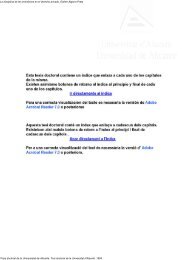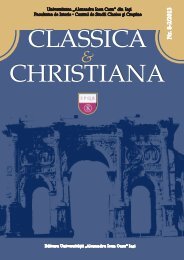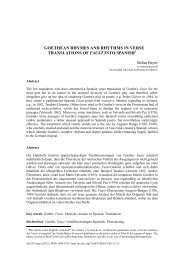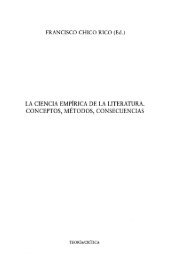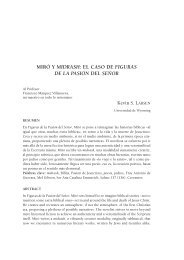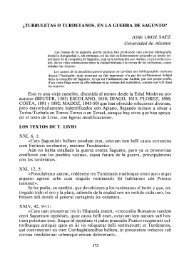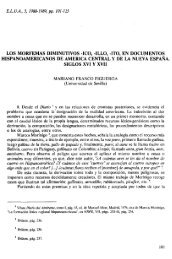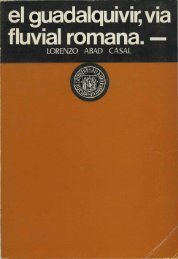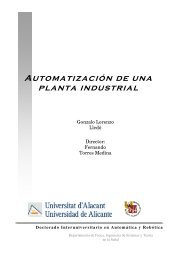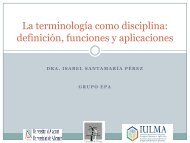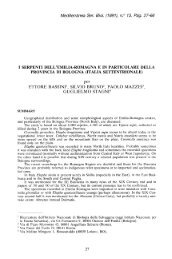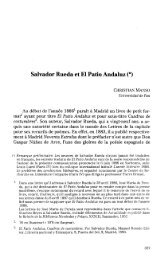Los celtÃberos - RUA - Universidad de Alicante
Los celtÃberos - RUA - Universidad de Alicante
Los celtÃberos - RUA - Universidad de Alicante
You also want an ePaper? Increase the reach of your titles
YUMPU automatically turns print PDFs into web optimized ePapers that Google loves.
UNIVERSIDAD COMPLUTENSE<br />
DE MADRID<br />
ALBERTO J. LORRIO<br />
UNIVERSIDAD DE ALICANTE
© Alberto J. Lorrio<br />
<strong>Universidad</strong> <strong>de</strong> <strong>Alicante</strong><br />
<strong>Universidad</strong> Complutense <strong>de</strong> Madrid, 1997<br />
ISBN: 84-7908-335-2<br />
Depósito Legal: MU-1.501-1997<br />
Edición <strong>de</strong>: Compobell<br />
Reservados todos los <strong>de</strong>rechos. No se permite<br />
reproducir, almacenar en sistemas <strong>de</strong> recuperación<br />
<strong>de</strong> la información ni transmitir alguna parte <strong>de</strong> esta<br />
publicación, cualquiera que sea el medio empleado<br />
–electrónico, mecánico, fotocopia, grabación, etc.–,<br />
sin el permiso previo <strong>de</strong> los titulares <strong>de</strong> los <strong>de</strong>rechos<br />
<strong>de</strong> la propiedad intelectual.<br />
Estos créditos pertenecen a la edición impresa<br />
<strong>de</strong> la obra<br />
Edición electrónica:
LOS CELTÍBEROS<br />
ALBERTO J. LORRIO<br />
Summary
Portada<br />
Créditos<br />
Índice<br />
Summary . . . . . . . . . . . . . . . . . . . . . . . . . . . . . . . . . . . . . 5
SUMMARY<br />
ÍNDICE<br />
Summary<br />
The existence of Celts in the Iberian Peninsula is attested<br />
by the linguistic evi<strong>de</strong>nce and by the information<br />
provi<strong>de</strong>d by the Graeco-Latin historians and geographers.<br />
The earliest <strong>de</strong>scriptions of the Celts, apart from the<br />
disputed Periplum of Avienus, come from Herodotus, who<br />
already in the 5th century B.C. said they were to be found in<br />
the Iberian Peninsula. However, it was not until the latter centuries<br />
of the pre-Christian era that the names of the peninsular<br />
Celtic tribes and the territories they occupied were known:<br />
the Celtiberian and Beron tribes in the Eastern Meseta, the<br />
Iberian System and the Middle Valley of the Ebro; the Celtic<br />
tribes in the Southwest; and various groups of Celtic fi liation,<br />
clearly differentiated from other non-Celtic tribes, in the<br />
Northwest, Galicia and the North of Portugal.<br />
According to the literary sources (Chapter II,1.1), Celtiberia<br />
was a large area in the interior of the Iberian Peninsula.<br />
There was not always unanimous agreement about its ter-<br />
5
ÍNDICE<br />
Alberto J. Lorrio<br />
<strong>Los</strong> Celtíberos<br />
ritorial boundaries, and there were substantial differences, if<br />
not contradictions, between the Graeco- Latin authors whose<br />
works refer to it in greater or lesser <strong>de</strong>tail. The sources sometimes<br />
<strong>de</strong>scribe Celtiberia as occupying a large area, roughly<br />
equivalent to the Meseta, which is the <strong>de</strong>scription found in the<br />
ol<strong>de</strong>st texts, written in the early years of the Conquest, and is<br />
how Strabo <strong>de</strong>scribed it, with Idoubeda -the Iberian Systemto<br />
the East, although he consi<strong>de</strong>red Segeda and Bilbilis, both<br />
located in the Middle Ebro Valley, to be Celtiberian towns.<br />
Together with this general concept, there is another more<br />
limited one which locates Celtiberia in the highlands of the<br />
Eastern Meseta and the Iberian System and in the lands on<br />
the right bank of the Middle Ebro Valley. Authors such as Pliny<br />
and Ptolemy do not offer a very clear <strong>de</strong>fi nition either. Thus<br />
Pliny (3, 19; 3, 25-27) consi<strong>de</strong>rs that the Celtiberians only inclu<strong>de</strong>d<br />
the Arevaci and Pelendones, whose occupation of the<br />
Upper Duero is well known, and the inhabitants of Segobriga.<br />
Ptolemy (2, 6) discusses the Arevaci and the Pelendones<br />
separately from the Celtiberians, to whom he attributes a<br />
number of towns located between the Middle Ebro and the<br />
Cuenca region.<br />
Thus the territorial limits of the Celtiberia <strong>de</strong>scribed by the<br />
classical writers are inexactly <strong>de</strong>fi ned, and must in any case<br />
6
Summary<br />
have changed in the course of time. Neither are the tribes<br />
inclu<strong>de</strong>d un<strong>de</strong>r the generic term of Celtiberian clear, although<br />
it seems beyond all doubt that the Arevaci, Belos, Titos,<br />
Lusones and Pelendones fell into that category. However, the<br />
inclusion of groups such as the Olca<strong>de</strong>s or Turboletas is more<br />
questionable.<br />
The theoretical Celtiberian territory <strong>de</strong>fi ned by the literary<br />
sources coinci<strong>de</strong>s, more or less, with the area covered by<br />
inscriptions in the Celtiberian language in the Iberian or Latin<br />
alphabet. There is also evi<strong>de</strong>nce of particular personal names<br />
restricted to Celtiberia which co-existed with others names of<br />
Indo-European origin which were more wi<strong>de</strong>ly spread through<br />
the West and North of the Peninsula. This picture of Celtiberia<br />
is that of a later period, at the time of the Roman Conquest<br />
or later, and we have to turn to the archaeological record to<br />
i<strong>de</strong>ntify the extent of Celtiberian territory in the centuries before<br />
the arrival of the Romans.<br />
An analysis of the settlements and the cemeteries, and also<br />
the weapons and the material culture, has ma<strong>de</strong> it possible<br />
to establish the cultural sequence of the Celtiberian world<br />
(Figure 143), so that for the fi rst time we have a general periodisation<br />
for this Culture which, although produced mainly<br />
from the funerary record, integrates the various manifesta-<br />
ÍNDICE<br />
7
Alberto J. Lorrio<br />
<strong>Los</strong> Celtíberos<br />
tions of Celtiberian Culture. Nevertheless, the diversity of the<br />
areas which make up this territory should be remembered,<br />
and also the unequal extent of our knowledge of them. The<br />
periodisation proposed suggests three successive phases,<br />
with a formative period for which the term Proto Celtiberian<br />
is reserved: an initial phase, or Early Celtiberian (ca. mid-6th<br />
century - mid-5th century B.C.), a phase of <strong>de</strong>velopment or<br />
Middle Celtiberian (ca. mid 5th century - end of the 3rd century)<br />
and a fi nal or Late Celtiberian phase (late 3rd-century<br />
- 1st century B.C.).<br />
The <strong>de</strong>monstrated continuity of use of the cemeteries whose<br />
seriation has been possible mainly thanks to an analysis of<br />
the military equipment left in the graves, fully justifi es the use<br />
of the term «Celtiberian» from at least the 6th century B.C.<br />
But that is why, initially, this term should be restricted to what<br />
can be consi<strong>de</strong>red the heartland of historical Celtiberia, limited<br />
to the highlands of the Eastern Meseta. This continuity<br />
is confi rmed by the settlements themselves, which display<br />
an evolution parallel to that recor<strong>de</strong>d in the cemeteries, as<br />
in the case of the material culture and the socio-economic<br />
structure.<br />
In this way it would seem more accurate to use the term<br />
Celtiberian to refer to a geographically and chronologically<br />
ÍNDICE<br />
8
ÍNDICE<br />
Summary<br />
well-<strong>de</strong>fi ned cultural system, which lasted unbroken from the<br />
6th century B.C. to the Roman Conquest. The continuity observed<br />
in the archaeological record would thus permit the use<br />
of an ethnic term from the formative period of this Culture, <strong>de</strong>spite<br />
the diffi culties that its use implies for referring to specifi c<br />
archaeological entities.<br />
A basic problem is that of explaining the formation of the<br />
Celtiberian Culture. Terms such as Urnfi eld Culture, Hallstatt,<br />
post-Hallstatt or Celtic have frequently been used in an attempt<br />
to establish a connection with European archaeology,<br />
thus more or less accepting the invasionist theories which<br />
relate the formation of the Celtiberians with the arrival of<br />
successive waves of Celts from Central Europe. This thesis<br />
was <strong>de</strong>fen<strong>de</strong>d by P. Bosch Gimpera (Chapter I,2), who, on<br />
the basis of historical information and evi<strong>de</strong>nce of a linguistic<br />
nature, postulated the existence of various invasions in an attempt<br />
to combine the historical and linguistic sources with the<br />
archaeological evi<strong>de</strong>nce. To do this he adopted the Central<br />
European sequence: Urnfi eld Culture-Hallstatt Culture-La<br />
Tène Culture, for the Iberian Peninsula. This opened up a<br />
constricting line of Spanish archaeological research, in view<br />
of the diffi culty of correlating these cultures with the cultures<br />
of the Iberian Peninsula, while the i<strong>de</strong>a of successive inva-<br />
9
ÍNDICE<br />
Alberto J. Lorrio<br />
<strong>Los</strong> Celtíberos<br />
sions was not confi rmed by the archaeological evi<strong>de</strong>nce (Ruiz<br />
Zapatero 1993). The hypothesis of invasions was maintained<br />
by the linguists (Chapter I,3), but without being able to offer<br />
any information on their chronology or the route by which<br />
they arrived. The ol<strong>de</strong>st, consi<strong>de</strong>red pre-Celtic, would inclu<strong>de</strong><br />
Lusitanian, a language which for some researchers should be<br />
consi<strong>de</strong>red a Celtic dialect, whilst the most recent would be<br />
so called Celtiberian, by this time fully Celtic (Chapter XI).<br />
The restriction of the Urnfi eld Culture to the Northeast of the<br />
Peninsula, linguistically an Iberian area, i.e. non Celtic and not<br />
even Indo-European, and the absence of that culture in celticised<br />
areas, ma<strong>de</strong> it necessary to reconsi<strong>de</strong>r the invasionist<br />
theories, since not even by accepting a single invasion, that<br />
of the Urnfi eld Culture, could the phenomenon of peninsular<br />
Celticisation be explained.<br />
The diffi culty of correlating the linguistic data and the archaeological<br />
evi<strong>de</strong>nce has led the two disciplines to go separate<br />
ways, which has ma<strong>de</strong> it diffi cult to obtain an all-embracing<br />
vision, since a linguistic hypothesis cannot be fully accepted<br />
if it does not acknowledge the archaeological evi<strong>de</strong>nce, and<br />
this cannot be explained without a coherent evaluation of the<br />
linguistic information.<br />
10
Summary<br />
One alternative interpretation has been proposed by M.<br />
Almagro-Gorbea (1986-87, 1987a, 1992a, 1993; Almagro-<br />
Gorbea & Lorrio 1987a), who takes as the starting point the<br />
diffi culty of maintaining that the origin of the Hispanic Celts<br />
can be related with the Urnfi eld Culture, which did not spread<br />
beyond the Northeastern quadrant of the Peninsula (Ruiz<br />
Zapatero 1985). In his view, their origin must be sought in the<br />
«Proto-Celtic» substrata preserved in the western regions of<br />
the Peninsula. The Celtiberian Culture would have emerged<br />
from this proto-Celtic substrata (Almagro-Gorbea 1992a,<br />
1993), and this would explain the various similarities between<br />
the two and the progressive assimilation of that substrata by<br />
the Celts.<br />
However, the paucity of information relating to the late Bronze<br />
Age in the Eastern Meseta (Chapter VII,1) makes it diffi cult<br />
to evaluate the substrata in the formation of the Celtiberian<br />
world, although certain evi<strong>de</strong>nce does seem to confi rm continuity<br />
of occupation, at least in the area where the Celtiberian<br />
phenomenon appeared with greatest force: the Upper Tagus-<br />
Upper Jalón-Upper Duero.<br />
At present the Celticisation of the Iberian Peninsula appears<br />
to have been a complex phenomenon in which a unique and<br />
very specifi c ethnic ingredient, implicit in the invasionist asser-<br />
ÍNDICE<br />
11
Alberto J. Lorrio<br />
<strong>Los</strong> Celtíberos<br />
tions, can no longer be consi<strong>de</strong>red an indispensable element<br />
for explaining the emergence and <strong>de</strong>velopment of peninsular<br />
Celtic Culture, of which the Celtiberians are the best-known<br />
group.<br />
However, there is evi<strong>de</strong>nce of ethnic characteristics originating<br />
in the Ebro Valley, recor<strong>de</strong>d in the highlands of the Eastern<br />
Meseta, as the settlement of Fuente Estaca (Martfnez Sastre<br />
1992), would appear to confi rm, with materials and a C14<br />
date of 800 ± 90 B.C., which permits it to be attributed to the<br />
Proto-Celtiberian period (Chapter VII, I). This was the stage<br />
immediately before the appearance of certain elements consi<strong>de</strong>red<br />
essential to the Celtiberian Culture, such as the cremation<br />
cemeteries or fortifi ed settlements.<br />
The possibility that these infi ltrating Urnfi eld groups may have<br />
brought with them an Indo-European language should not be<br />
rejected, even if their true role in creating the Celtiberian world<br />
has yet to be evaluated. At the present stage of research<br />
it would be hazardous -but tempting, none the less- to link<br />
the arrival of these groups with the introduction of a « proto-<br />
Celtiberian» language, a term used by <strong>de</strong> Hoz (1993a: 392,<br />
footnote 125) to refer to «any stage of language which comes<br />
between Celtic before its differentiation into dialects and the<br />
historical Celtiberian attested by the inscriptions».<br />
ÍNDICE<br />
12
ÍNDICE<br />
Summary<br />
Be that as it may, the trans-Pyrenean origin of the Urnfi eld<br />
groups of the Northeast would seem beyond all doubt, the<br />
penetration, at least it its initial phases (which can be put<br />
around 1100 B.C.) of human groups, which were of little importance<br />
in <strong>de</strong>mographic terms (Ruiz Zapatero 1985; Maya &<br />
Barbers 1992: 176 ff.), being accepted. In view of the continuity<br />
of the material culture in the Northeast through the fi rst millennium,<br />
if the Indo European character of this contribution is<br />
accepted, a possible explanation of the continuing dominance<br />
of an Iberian language at a late date is what Villar (1991: 465<br />
f.) calls «failed Indo-Europeanisation». According to this theory<br />
the Indo-European languages of the Northeast, probably in<br />
the minority, must have waned as those who spoke them were<br />
culturally and linguistically «Iberianised». That at least some<br />
of the Urnfi eld groups spoke an Indo-European language of a<br />
Celtic or proto Celtic type seems very probable. Thus it could<br />
be postulated that «either the migratory Urnfi eld groups were<br />
so small they did not succeed in imposing their own language<br />
on the peoples of the substrata, or the Iberian transformation<br />
largely erased the Indo-European linguistic features that<br />
had hypothetically been assumed by the natives» (Maya &<br />
Barbers 1992: 176).<br />
13
ÍNDICE<br />
Alberto J. Lorrio<br />
<strong>Los</strong> Celtíberos<br />
The transition of the 7th-6th centuries B.C. saw the shaping<br />
of what has been called the Early Celtiberian, evi<strong>de</strong>nce for<br />
which is found in the highlands of the Eastern Meseta and the<br />
Iberian System. It was characterised by important innovations<br />
in patterns of settlement, burial rites and technology, with the<br />
adoption of an iron-working metallurgy. The fi rst stable settlements<br />
in this territory appear at this time. Several settlement<br />
attributed to this phase are of the fortifi ed type, although other<br />
highland sites without artifi cial <strong>de</strong>fences are also documented.<br />
The ol<strong>de</strong>st cemeteries on the Eastern Meseta can also be<br />
dated to this period, their continuous use from the 6th to the<br />
2nd centuries B.C., or even later, having already been mentioned.<br />
Some of them display a characteristic internal organization,<br />
with lines of graves, which are generally marked with<br />
stelae (Chapter IV,2). The grave goods indicate that the society<br />
had a strong warrior component, with a hierarchical social<br />
structure, the weapons -notable for the long spearheads and<br />
the absence of swords or daggers- appearing as an external<br />
symbol of prestige (Chapter IX, 1).<br />
The appearance of the Celtiberian elites could be due to the<br />
rise of dominant groups in the Cogotas I Culture of the Late<br />
Bronze Age, although there may have been external <strong>de</strong>mographic<br />
factors (Almagro-Gorbea 1993: 146 f). The true part<br />
14
ÍNDICE<br />
Summary<br />
played by these factors in this process is, however, diffi cult<br />
to <strong>de</strong>termine. Certainly the new socio economic organisation<br />
would have led to a growing concentration of wealth and<br />
power in the hands of those who controlled resources such<br />
as grazing lands, saltworks -essential for stockraising and<br />
ironworking- or iron production, which ma<strong>de</strong> it possible to<br />
produce effective weapons at an early date, thus explaining<br />
the <strong>de</strong>velopment of a progressively more hierarchical warrior<br />
society.<br />
An analysis of the material culture of the cemeteries and settlements<br />
in the initial phase of the Celtiberian Culture reveals<br />
the existence of contributions from various origins and a variety<br />
of cultural traditions. With regard to the objects found<br />
amongst the grave goods, it can be postulated that some of<br />
these came from the South, such as some double-springed<br />
broochs, belt buckles that had between one and three hooks,<br />
or the fi rst iron objects, including long spearheads and curved<br />
knives. Another possibility, by no means exclusive, is that<br />
some of these elements came from areas close to the colonial<br />
world in the Northeast of the Peninsular via the Ebro<br />
Valley, together with the ritual itself, cremation, and the urns<br />
that formed part of it; this would be confi rmed by their shapes,<br />
which can be linked with the Urnfi elds. A similar origin has<br />
15
Alberto J. Lorrio<br />
<strong>Los</strong> Celtíberos<br />
been suggested for the tumulus burials of the Eastern Meseta<br />
which, however, are very poorly documented. On the other<br />
hand, the presence of stelae lined up is a local feature, unparalleled<br />
in the Urnfi elds or the Celtic world.<br />
The chronology of this initial phase of the Celtiberian cemeteries<br />
is not easy to <strong>de</strong>termine since practically the only<br />
elements which can be more or less reliably dated are the<br />
broochs.<br />
The fi nd of «chevaux-<strong>de</strong>-frise» associated with a wall and rectangular<br />
towers in a settlement in Catalonia has led to reconsi<strong>de</strong>ration<br />
of how this <strong>de</strong>fensive system originated. It is found<br />
in an Iron Age Urnfi eld setting, and is dated to the second half<br />
of the 7th century B.C. (Garcés et al. 1991, 1993). This dating,<br />
earlier than those commonly accepted for the Sorian hillforts,<br />
and its geographical location in the Lower Segre, would<br />
confi rm the Central European fi liation established for it by<br />
Harbison (1971), with the woo<strong>de</strong>n stocka<strong>de</strong>s of the Hallstatt<br />
C.<br />
The type of settlement (Chapter III), consisting of rectangular<br />
houses with walls closed to the outsi<strong>de</strong> to form a rampart,<br />
characteristic of the Celtiberian world, but not exclusive to<br />
it, is likewise well recor<strong>de</strong>d in the Urnfi eld settlements of<br />
ÍNDICE<br />
16
Summary<br />
the Northeast, although this urban layout is known from the<br />
Middle Bronze Age.<br />
The presence of the elements analysed, and the different<br />
infl uences referred to in the Eastern Meseta, should not necessarily<br />
be related with movements of population but should<br />
not exclu<strong>de</strong> them either, since the role of the indigenous<br />
substrate in this process has yet to be <strong>de</strong>termined. However,<br />
the existence of ethnic contributions from the Ebro Valley is<br />
attested in the area, as the open settlement of Fuente Estaca<br />
<strong>de</strong>monstrates.<br />
From the 5th century B.C. and for the next two centuries the<br />
Middle Celtiberian period <strong>de</strong>veloped, in the course of which<br />
regional variations appeared which make it possible to <strong>de</strong>fi ne<br />
cultural groups which can sometimes perhaps be related with<br />
the populi known from the literary sources. An analysis of the<br />
cemeteries, and principally of the metal objects placed in the<br />
graves, particulary weapons, has enabled this period to be<br />
divi<strong>de</strong>d into various subphases, which however are diffi cult to<br />
correlate with the information obtained from the settlements,<br />
sometimes only known through surface materials (Chapter<br />
VII,3). At the end of this period the lands of the right bank<br />
of the Middle Ebro Valley appear to be fully integrated into<br />
Celtiberia, although it is not yet suffi ciently clear when and<br />
ÍNDICE<br />
17
Alberto J. Lorrio<br />
<strong>Los</strong> Celtíberos<br />
how what might be termed the « Celtiberisation» of this area<br />
occurred (Royo 1990: 130 f., fi gure 2).<br />
The cemeteries emphasise growing social distinctions, with<br />
the appearance of aristocratic tombs containing grave goods<br />
that consist of a good number of artefacts, some of which can<br />
be consi<strong>de</strong>red exceptional, such as the bronze weapons or<br />
the wheel-turned pottery (Chapters VII,3.1.1 and IX,2). This<br />
important <strong>de</strong>velopment initially appears to be restricted to<br />
the Upper Henares-Upper Tajufi a, and to the southern part of<br />
the province of Soria belonging to the Upper Duero and the<br />
Upper Jalón rivers. It could be related to the livestock wealth<br />
of the area, control of the saltworks or the production of iron,<br />
but its privileged geographic situation should not be forgotten,<br />
since this area constitutes a natural pass between the Ebro<br />
Valley and the Meseta. The proliferation of cemeteries in this<br />
area could be associated with an increase in the <strong>de</strong>nsity of<br />
the population, which would imply more systematic occupation<br />
of the land.<br />
The grave goods of the warrior tombs inclu<strong>de</strong> swords, of the<br />
antenna and frontón types, which are recor<strong>de</strong>d together in the<br />
South of the Peninsula from the beginnings of the 5th century<br />
B.C. Spearheads, usually accompanied by their ferrules, are<br />
also present. The panoply is completed with the shield, which<br />
ÍNDICE<br />
18
ÍNDICE<br />
Summary<br />
has a boss of bronze or iron, the curved-back knife, and, in<br />
some cases, bronze disc-breastplates and helmets. Horse<br />
harnesses are frequently found with them, which indicates<br />
the high status of the personages with whom these objects<br />
were placed.<br />
With regard to the origin of the different types of objects found<br />
in the graves, various infl uences are clear: on one hand, from<br />
the North of the Pyrenees, through the Ebro Valley, and on<br />
the other, from the lands of the South and the East of the<br />
Peninsula, of Mediterranean inspiration. A good example of<br />
this is offered by the weapons, perhaps the most signifi cant<br />
elements of the grave goods. Thus the various types of antenna<br />
swords refl ect two infl uences, one from Languedoc,<br />
certainly through Catalonia, as would seem to be the case of<br />
the Aguilar <strong>de</strong> Anguita type, and Aquitaine, as the few examples<br />
of the Aquitanian type would confi rm, which are certainly<br />
imported pieces, and the Echauri type swords. The local<br />
character of the antenna swords of the Aguilar <strong>de</strong> Anguita<br />
and Echauri types <strong>de</strong>monstrate the consi<strong>de</strong>rable metallurgical<br />
<strong>de</strong>velopment in the Eastern Meseta from an early date.<br />
A different origin could be <strong>de</strong>fen<strong>de</strong>d for the frontón swords,<br />
which can be assumed to be of Mediterranean origin, coming<br />
19
Alberto J. Lorrio<br />
<strong>Los</strong> Celtíberos<br />
from the South of the Peninsula at the beginning of the 5th<br />
century B.C.<br />
Similarly, a foreign origin can be postulated for the bronze<br />
weapons -helmets, breastplates and large bosses-, which<br />
display similar themes and <strong>de</strong>corative technique and thus<br />
suggest a common origin, although the possibility that they<br />
were ma<strong>de</strong> in local workshops cannot be discounted. This<br />
foreign origin is particularly obvious in the case of the discbreastplates,<br />
which are inspired by Italic pieces and for which<br />
a 5th century B.C. date is proposed (Chapter VII,3.1.1).<br />
The other materials, such as various kinds of broochs, belt<br />
buckles, spiral adornments or pectorals ma<strong>de</strong> from bronze<br />
plates, display similarities with a wi<strong>de</strong> variety of items from different<br />
periods and places, frequently Mediterranean, attesting<br />
various origins and ways of arrival, although in many cases<br />
they could be locally produced pieces, as the geographical<br />
dispersion of the fi nds <strong>de</strong>monstrates. An origin in the Iberian<br />
area is evi<strong>de</strong>nt in the case of the fi rst wheel-turned pieces arriving<br />
in the Eastern Meseta.<br />
From the end of the 5th century the progressive displacement<br />
of the centres of wealth towards the lands of the Upper Duero<br />
can be observed. This can be related with the outstanding<br />
role played from this time on by one of the most powerful<br />
ÍNDICE<br />
20
Summary<br />
Celtiberian populi: the Arevaci. This is <strong>de</strong>monstrated by the<br />
high proportion of graves containing weapons in the cemeteries<br />
located on the right bank of the Upper Duero that can be<br />
attributed to this period. This coinci<strong>de</strong>s with the impoverishment<br />
of the grave goods, including the virtual disappearance<br />
of weapons, in other parts of Celtiberia (Chapter VII,11.1 and<br />
IX,3).<br />
The presence of Iberian-type weapons is unusual in the<br />
Upper Duero, while from the mid-4th century B.C. onwards<br />
La Tène type swords appeared in the cemeteries of the Upper<br />
Henares-Upper Jalón, and reached their fullest expression<br />
the following century, authentic La Tène pieces having been<br />
recor<strong>de</strong>d, as the fi nd of certain sword scabbards would indicate<br />
(Chapter V,2.2.1.1).<br />
Given the entirely indigenous characteristics of the panoplies<br />
to which these weapons belong, it is possible that they were<br />
brought by Celtiberian mercenaries or were perhaps exotic<br />
pieces that arrived through exchanges of prestige goods.<br />
With regard to the settlements, new systems of <strong>de</strong>fence were<br />
incorporated during this phase, such as buttressed walls and<br />
rectangular towers, which co-existed with the characteristics<br />
« chevaux-<strong>de</strong>-frise», already recor<strong>de</strong>d in the earlier phase<br />
(Chapters III,2 and VII).<br />
ÍNDICE<br />
21
ÍNDICE<br />
Alberto J. Lorrio<br />
<strong>Los</strong> Celtíberos<br />
The period between the end of the 3rd century B.C. and the<br />
1st century B.C., the Late Celtiberian, seems to be a period<br />
of transition and profound change in the Celtiberian world<br />
(Almagro-Gorbea & Lorrio 1991).<br />
Its most outstanding feature could be the trend towards an<br />
increasingly urban way of life, which should be seen in relationship<br />
to the preceding process of urbanisation in the<br />
Tartessian-Iberian world and the appearance of oppida in<br />
Central Europe. This is shown by the grouping of towns<br />
into fe<strong>de</strong>rations referred to in the sources, and the possible<br />
transformation of the funerary i<strong>de</strong>ology refl ected by the grave<br />
goods, which could explain the increasing appearance of jewellery,<br />
perhaps as an element of status replacing weapons as<br />
a social symbol. A strong Iberian infl uence can be observed<br />
in the bronze and pottery objects, which gives them a <strong>de</strong>fi nite<br />
personality within the Celtic world to which these creations<br />
belonged, as their stylistic and i<strong>de</strong>ological elements attest.<br />
Within this process of urbanisation the probable appearance<br />
of writing should be consi<strong>de</strong>red (<strong>de</strong> Hoz 1986a, 1995a).<br />
Coinage - dated from the mid-2nd century B.C.- provi<strong>de</strong>s<br />
evi<strong>de</strong>nce of writing, but the diversity of alphabets and their<br />
rapid adoption suggests it arrived from the Iberian areas to<br />
the South and East at an earlier date. The existence of laws<br />
22
Summary<br />
written in bronze (Fatás 1980; Beltran & Tovar 1982) and the<br />
<strong>de</strong>velopment of a truly monumental architecture should also<br />
be mentioned (Beltran 1982; Almagro-Gorbea 1994a: 40)<br />
(Chapter III,4).<br />
For this fi nal phase, we have the information provi<strong>de</strong>d by<br />
the literary sources, which makes it possible to analyse the<br />
socio-political organisation of the Celtiberians in <strong>de</strong>pth, and<br />
provi<strong>de</strong>s a more complex panorama than that available from<br />
the archaeological evi<strong>de</strong>nce alone (Chapter IX,4). There are<br />
<strong>de</strong>scriptions of family or supra-family kinship groups, sociopolitical<br />
institutions such as senates or assemblies, non-kin<br />
institutions such as the hospitium, client or age groups, and<br />
ethnic and territorial entities whose names are known for the<br />
fi rst time. These same sources offer information of great interest<br />
on the economic organisation of the Celtiberians, and<br />
coinci<strong>de</strong> in <strong>de</strong>scribing their society as being predominantly<br />
pastoral in character, which would have been complemented<br />
with subsistence farming (Chapter VIII, I).<br />
Another key feature of this period appears to be the continuing<br />
expansion of the Celtic world in the Iberian Peninsula,<br />
apparently from one nucleus, largely i<strong>de</strong>ntifi able with the<br />
Celtiberia of the written sources. This process, according to<br />
archaeological and historical evi<strong>de</strong>nce, was still fully active<br />
ÍNDICE<br />
23
Alberto J. Lorrio<br />
<strong>Los</strong> Celtíberos<br />
in the 2nd century B.C. (Almagro-Gorbea 1993: 154 ff.), and<br />
would have exten<strong>de</strong>d westwards, as proved by the geographical<br />
dispersion of the horse broochs (Figure 8,A) or genuinely<br />
Celtiberian weapons such as the bi-globular type dagger<br />
(Figure 8,B), which even reached the lands of Celtic Beturia.<br />
This coinci<strong>de</strong>s with the information provi<strong>de</strong>d by the literary<br />
sources (Pliny 3, 13) and the linguistic and inscriptional evi<strong>de</strong>nce<br />
(Chapters II,2 and XI).<br />
The phenomenon of Celtiberian expansion in the Iberian<br />
Peninsula, in a similar way to Italy, came up against a<br />
parallel expansion of the urban Mediterranean world. The<br />
Carthaginians, from the last third of the 3rd century B.C., and,<br />
subsequently, the Roman world, initiated a series of confrontations<br />
which would culminate in the Celtiberian Wars, one of<br />
the main episo<strong>de</strong>s in the process of shock, absorption and<br />
<strong>de</strong>struction of the Celtic world by Rome.<br />
By way of a fi nal refl ection, some points of interest can be<br />
ma<strong>de</strong>:<br />
1. The historical and linguistic evi<strong>de</strong>nce enables the<br />
Celtiberians to be clearly <strong>de</strong>fi ned as having an ethnic i<strong>de</strong>ntity<br />
and a Celtic language of their own during the 2nd and 1st centuries<br />
B.C. The area <strong>de</strong>scribed in the classical sources and indicated<br />
by the linguistic evi<strong>de</strong>nce has its own archaeological<br />
ÍNDICE<br />
24
Summary<br />
personality. But the Celtiberian Culture of the latter centuries<br />
B.C. is simply the culmination of an unbroken historical process<br />
which had its origins in the 6th century B.C., so from that<br />
time onwards the term Celtiberian can legitimately be used for<br />
the communities of the Upper Duero and the Upper Tagus.<br />
Archaeological study of the Celtiberian region has uncovered<br />
very little information for the 8th and 7th centuries B.C., theoretically<br />
Proto-Celtiberian, and the same is true of the fi nal<br />
stages of the Late Bronze Age. This is a serious problem<br />
which is now beginning to be tackled.<br />
2. If, as we have said, the Celticisation of the Iberian<br />
Peninsula did not occur through the Urnfi eld communities of<br />
the Northeast, and there were no migrations or breaks in the<br />
general sequence of the Celtiberian period, then the explanation<br />
has to be sought at the beginning of the period, ca. 600<br />
B.C., and the period immediately before.<br />
3. The implantation of a language such as Celtiberian <strong>de</strong>mands<br />
a «critical mass», i.e. a fairly large population in which<br />
the majority were speakers of the Celtic language. Therefore<br />
some kind of proto-Celtiberian language must already have<br />
existed in the 6th century B.C. in an area where Indo-<br />
European elements had doubtless ma<strong>de</strong> their mark at an earlier<br />
date. This would explain the famous remark of Herodotus<br />
ÍNDICE<br />
25
Alberto J. Lorrio<br />
<strong>Los</strong> Celtíberos<br />
(2, 33; 4, 49) that there were Celts in the Iberian fi nisterre in<br />
the 5th century B.C.<br />
4. It is evi<strong>de</strong>nt that there were Celtiberian elements in areas<br />
which were not strictly speaking Celtiberian, and this can be<br />
interpreted as indicative of the processes of Celtiberianisation,<br />
given the expansive force of this culture, and therefore, of<br />
Celticisation of these territories. This would not have required<br />
large-scale ethnic movements but could have been<br />
an intermittent process that had a cumulative effect, with a<br />
few dominant groups imposing themselves, local migrations<br />
or even the acculturation of the substrata (Almagro-Gorbea<br />
1993: 156). The dispersal of Celtiberian weapons -such as<br />
the bi-globular daggers- can be seen as indicative of this expansion<br />
and the consequent process of Celticisation, and it is<br />
also attested by the distribution of the ethnic personal names<br />
Celtius and Celtiber and their variants, of place-names ending<br />
in -briga, etc., a fact evi<strong>de</strong>nced by texts in the Celtiberian<br />
language in non-Celtiberian parts of the Meseta and more<br />
remote areas.<br />
In any case, the phenomenon of Celticisation ten<strong>de</strong>d to occur<br />
towards the West of the peninsula, possibly because the<br />
tribes in these areas belonged to a common Indo-European<br />
substrata and were also noted for their wealth in terms of<br />
ÍNDICE<br />
26
Summary<br />
livestock, which must have attracted the attention of the<br />
Celtiberian peoples in their process of expansion.<br />
5. Seen in this way, the Celtic world would have changed in<br />
the course of time and from one place to another, and cannot<br />
therefore be regar<strong>de</strong>d as a monolithic unit, and this is largely<br />
confi rmed as the data increases, indicating consi<strong>de</strong>rable<br />
complexity.<br />
6. We would emphasise the distinctive personality of the Celtic<br />
world in the Peninsular and, within in it, Celtiberia, compared<br />
with the Celtic world on the other si<strong>de</strong> of the Pyrenees. This<br />
is explained by its consi<strong>de</strong>rable exposure to the infl uence of<br />
Iberian Culture, displayed in aspects such as the adoption of<br />
the potter’s wheel, the technology of working with fi ne metals,<br />
the type of weapons used, coinage, writing, etc. In addition<br />
there is its marginal situation at the western end of Europe,<br />
remote from the cultural currents which had a <strong>de</strong>cisive effect<br />
on the continental Celts, who can be i<strong>de</strong>ntifi ed, with the<br />
Hallstatt and La Tène cultures.<br />
7. The Celtiberians came in this way to be a very important<br />
part of Celtic Culture, although scholars of the Celts have often<br />
exclu<strong>de</strong>d the Iberian Peninsula from their general monographs<br />
on this proto-historical people, basically because<br />
they have i<strong>de</strong>ntifi ed the Celts with the Hallstatt and La Tène<br />
ÍNDICE<br />
27
Alberto J. Lorrio<br />
<strong>Los</strong> Celtíberos<br />
cultures. The importance of the Celtiberian Culture can best<br />
be un<strong>de</strong>rstood within the processes of ethnogenesis of the<br />
Iberian Peninsula and the general framework of the Celtic<br />
world.<br />
ÍNDICE<br />
28



